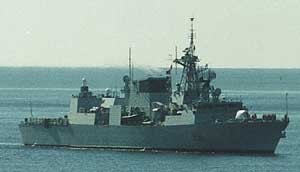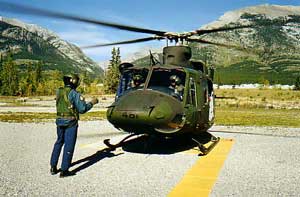 Canada
is sending one of its largest warships, a squadron of
helicopters and 200 ground troops to the high Arctic
this summer in an exercise designed to show the flag
-- and a little military muscle -- in the North.
Canada
is sending one of its largest warships, a squadron of
helicopters and 200 ground troops to the high Arctic
this summer in an exercise designed to show the flag
-- and a little military muscle -- in the North.
And while the military says the
three-week-long exercise, code-named Narwhal, has
nothing to do with Denmark's claim to a tiny island in
the far North, it will be the largest Canadian Forces
exercise ever in the Arctic.
"This is a first," Colonel Norris
Pettis, commander of the Canadian Forces northern
area, said yesterday.
"This is the first time we'll have a
joint naval, air and land force operating this far
north. And it's sending a message that this land is
important to us ... that we can put troops, and
aircraft and ships, on the ground to respond to
whatever we might be called upon to deal with.
"It's putting a military presence up
here ... flexing our muscles."
 The
patrol frigate HMCS Montreal is to sail sometime in
August to the Arctic, where it will be joined by five
CH-146 Griffon helicopters and two companies of the
2nd Battalion, Royal Canadian Regiment, the largest
combined force that has ever operated in the North.
The
patrol frigate HMCS Montreal is to sail sometime in
August to the Arctic, where it will be joined by five
CH-146 Griffon helicopters and two companies of the
2nd Battalion, Royal Canadian Regiment, the largest
combined force that has ever operated in the North.
Col. Pettis said such a "robust"
military presence in the desolate tundra of Baffin
Island will not go unnoticed.
"It sends a message, first of all to
the people of the North, secondly to all Canadians and
certainly to whatever other countries out there may be
watching that we are here and that this place is
important to us," he said in a telephone interview
from his headquarters in Yellowknife. "This is an
attempt to demonstrate that we are here and we are
paying attention to what happens in the North."
Meanwhile, Canadian diplomats are
considering an offer from the Danish ambassador to
negotiate the future of Hans Island, a
three-kilometer-long stretch of rock and ice in the
Nares Strait between Ellesmere Island and Greenland.
Svend Roed Nielsen, the Danish
government's top representative in Canada, told the
National Post this week that he is willing to start
"negotiating" with Canada.
However, he added that his
government is not backing down from its claim that the
barren and uninhabited island is in Danish territory.
Reynald Doiron, a Foreign Affairs
spokesman, said Ottawa is considering a response to
the ambassador's offer, but added that Canada is not
backing down either. "Our position is that the island
is ours; their position is that the island is theirs,"
he said.
"As far as Canada-Danish relations
are concerned we have tried to keep this low-key [but]
we have agreed to disagree."
Hans Island does not even appear on
most maps, but it has become a focus of challenges to
Canada's sovereignty over the Arctic archipelago,
where islands and waterways long claimed as Canadian
are facing challenges from foreign governments.
Danish warships showed up off its
coast in the summer of 2002. A group of sailors
disembarked and reportedly hoisted the Danish flag,
actions which Canada considered a violation of its
sovereignty.
Dr. Richard Gimblett, a former
Canadian navy officer who is now a research fellow
with Dalhousie University's Centre for Foreign Policy
Studies, said the upcoming exercise will send a
significant message in the North.
"If you're laying claim to a piece
of land you have to use it -- you have to show that
you can go there, stay there and control it," he said.
"The Canadian Forces is a good way to help establish
that."
However, Dr. Gimblett said that the
Canadian navy is limited in what it can do in the
North since its front-line warships -- patrol frigates
like HMCS Montreal and its Iroquois-class destroyers
-- cannot venture into even loosely packed ice in
Arctic waters.
"It would be nice if we had ships
that could go up there year-round, but we don't," he
said.
And with global warming making the
northwest passage through Canada's Arctic navigable
for longer stretches every year, he said we will need
a naval capability in the North very soon.
"Within 10 or 15 years the passage
could be open year-round," he said. "It has the
potential to become a super-highway for shipping
between Europe and east Asia."
Exercise Narwhal will cost an
estimated $5-million and the logistics of transporting
and supporting so many soldiers, sailors and airmen to
such an isolated area will be formidable, Col. Pettis
said.
"It's going to be a challenge just
getting them here," he said. "It's just a few hundred
kilometers from Iqaluit, but there aren't any roads.
So it's an achievement just getting them where they're
supposed to be going."
The exercise will be the "cap stone"
in a series of military moves in the North designed to
bolster Canada's claim over the vast stretches of the
uninhabited Arctic, Col. Pettis said.
Canada has launched a five-year plan
to increase its military presence throughout its
uninhabited Arctic territory, including satellite
surveillance and far-reaching patrols of soldiers
riding snowmobiles.
A patrol of Canadian Rangers is to
leave next week on a long-distance trek to Alert.
© National Post 2004